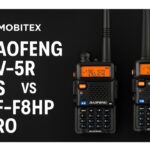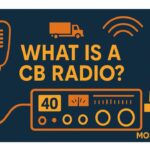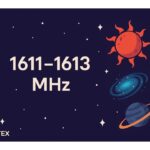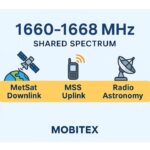Frequency
1323 MHz
Range
1300–1400 MHz
Band Group
L‑Band Radiolocation Core (1300–1349 MHz)
🌐 Summary
The 1323 MHz allocation is part of the L‑Band Radiolocation Core (1300–1349 MHz) spectrum. This range is used worldwide for critical applications that keep our communications and infrastructure running smoothly. On this page we highlight how each band is applied in real systems, from regulatory assignments to everyday devices. Our goal is to make spectrum data clear and practical for engineers, regulators, and enthusiasts alike.
Key uses of this band include: L‑band slice dominated by radiolocation/aeronautical radionavigation with RNSS L3 (~1381 MHz) coexistence. Guard towards the protected 1400–1427 MHz passive band (EESS/RAS); apply strict OOBE and filtering..
RNSS L3 ~1381 MHz; maintain guard to 1400–1427 MHz passive services

🔍 Explore the full RF Spectrum database
📡 Band & Geometry key
| Field | Value |
|---|---|
| Wavelength (m) | 0.2266 |
| Waveforms | Pulsed/FMCW radar; RNSS spread-spectrum |
| Antenna Form Factor (Typical) | Radar dishes/arrays; RNSS patch/ceramic (receive) |
| Band Family | Radiolocation / L‑Band Navigation |
| Band | 1300–1350 MHz Radiolocation & Aeronautical Radionavigation |
| Primary Common Name | L-band |
| FSPL @ 1 km [dB] | 94.87 |
| FSPL @ 10 km [dB] | 114.87 |
| Fresnel Radius @ 1 km (m) | 7.527 |
| Band Group | L‑Band Radiolocation Core (1300–1349 MHz) |
| Tax Band Family | UHF/L-band Transition |
| Tax Band Class | 1300 MHz – 1400 MHz UHF/L-band Transition Radiolocation / Aeronautical |
🧩 Applications & Usage
| Field | Value |
|---|---|
| Primary Application | Radiolocation and aeronautical radionavigation (e.g., ASR/MSSR radar) |
| Lower Neighbor Use | Amateur (23 cm) & RNSS (≤1300 MHz) |
| Upper Neighbor Use | Passive services (≥1400 MHz) — EESS/RAS protections |
| Typical Services Devices | – |
| Market Common Devices | Radar arrays, avionics, RNSS receivers |
| Refarming Use | – |
| Device Ecosystem Size | Large for RNSS receivers; specialized radar |
| Device Hotspots (MHz) | 1381.05 |
| Device Category | Radar / RNSS (receive) |
| Typical Use Cases | Aviation surveillance, navigation support |
| Modulation (Device) | Pulse/FMCW; RNSS spread-spectrum |
| Channel Width (Device) [kHz] | Mode-dependent (radar); RNSS spread |
| Device Region Profiles | Global RNSS; radar licensed per nation |
| Per-Region EIRP Or Duty (Device) | Licensed radar ERP; RNSS receive-only |
| Allocation Relevance (Device) | Navigation, surveillance |
| Adjacent-Band Collision Risks (Device) | 23 cm emissions below; passive band above; RNSS L3 center |
| Example Devices Or Skus | Avionics GNSS receivers; radar systems |
| Common Protocols | Pulse compression, FMCW; RNSS codes |
🗒️ Notes
| Field | Value |
|---|---|
| Receiver Selectivity Notes | Filtering around ~1381 MHz (GPS L3) advisable for nearby services |
| Interference Notes | Apply filtering/notches; control ERP; maintain exclusion zones near sensitive sites |
| Compatibility Risk Notes | RNSS coexistence; coordinate radar emissions; manage OOBE |
| Notes | RNSS L3 ~1381 MHz; maintain guard to 1400–1427 MHz passive services |
| Propagation Notes | LOS limited; low rain attenuation; terrain/obstruction sensitive |
⚙️ Technical Rules
| Field | Value |
|---|---|
| Lower Band Frequency Limit | 1300 |
| Upper Band Frequency Limit | 1400 |
| EIRP Indoor Limits | Not typical (radar); RNSS is receive-only |
| EIRP Outdoor Limits | Per national license; radar site-specific |
| PSD Limit | Emission constraints to protect RNSS (~1381 MHz) and 1400–1427 MHz passive services |
| Emission Mask Class | Service-specific (radar/RNSS) |
| Guardband Minimum [kHz] | 1000 |
| Typical Bandwidths | 1–20 MHz (radar); RNSS spread-spectrum (receive) |
| Autocalculated Bandlimits | 1300.0–1400.0 MHz |
| Typical Bandwidths (Estimated) | 1–20 MHz (radar); RNSS spread-spectrum (receive) |
| Max EIRP [dBm] | Licensed radar ERP; RNSS receive-only |
| Power Source Or Duty Profile (Typical) | Radar high-power pulse/FMCW; RNSS low-power receive |
| Channelization Plan | Not channelized; service-specific |
| Channelization | Not channelized; service-specific radar/RNSS waveforms |
| Guard Band Requirement | ≥1 MHz typical; adjust per license/notice |
| OOB Emission Limit [dBm/MHz] | Strict OOBE to protect RNSS and passive bands |
| Spurious Emission Limit (dBm) | Service-specific; protect safety/passive services |
| RX Blocking Min [dBm] | High blocking required near strong radar emissions |
| Duplexing | Unpaired |
| Duplexing Information | Unpaired allocations; radar coordinated/licensed; RNSS receive-only |
| Uplink Pairing | Not applicable (unpaired) |
| Downlink Pairing | Not applicable |
| Paired Band Info | Not applicable |
| Max EIRP [dBm] | Per national radar licensing; RNSS receive-only |
| Channelization Block Size | – |
| 3GPP Band Number | |
| Example 3GPP Bands | None (non‑3GPP services) |
| LTE Uplink Bands | None |
| LTE Downlink Bands | None |
| NR Uplink Bands | None |
| NR Downlink Bands | None |
| Guard Bands | Use ≥1 MHz guard band for radar site coexistence; ensure filtering to reduce adjacent‑band leakage into RNSS services below 1300 MHz. |
| Protocol Or Standard | RNSS L3; radar pulse/FMCW |
🌎 Country Overrides
| Field | Value |
|---|---|
| Tax Service Category | Other / Various |
| Tax License Type | Licensed / Coordinated (Radiolocation/Aeronautical); RNSS protections near ~1381 MHz |
| Tax Regions | Global (ITU Regions 1/2/3) — national variations |
| ITU Region 1 (Europe, Africa, Middle East (west of Persian Gulf), Western Russia & Mongolia) | Region 1 (EMEA): Radiolocation/Aeronautical primary in this slice; RNSS coexistence recognized. Standard protections apply; coordinate radar use; manage OOBE. |
| ITU Region 2 (North America, South America, Central America, Caribbean, Greenland, Eastern Pacific Islands (Americas region)) | Region 2 (Americas): Radiolocation/Aeronautical primary; RNSS L3 protection emphasized in national rules. Standard protections apply; coordinate radar use; manage OOBE. |
| ITU Region 3 (Asia, Australia, Pacific Islands, Oceania, Indian Subcontinent, East Asia & Southeast Asia) | Region 3 (APAC): Radiolocation/Aeronautical common; RNSS protection and passive band safeguards apply. Standard protections apply; coordinate radar use; manage OOBE. |
| License Type | Licensed / Service-Specific |
| Primary Application | Radiolocation and aeronautical radionavigation (e.g., ASR/MSSR radar) |
| Primary Services | Radiolocation, Aeronautical Radionavigation |
| Spurious Emission [dBm] | Service-specific; protect safety/passive services |
| Lower Neighbor Use | Amateur (23 cm) & RNSS (≤1300 MHz) |
| Upper Neighbor Use | Passive services (≥1400 MHz) — EESS/RAS protections |
| Licensing Model | Service-specific licensing (government/assigned); Amateur uses national amateur licensing |
| Typical Services Devices | – |
| US FCC Alloc | Radiolocation; Aeronautical Radionavigation; RNSS coexistence; emission controls apply.– |
| CA IC Alloc | Radiolocation; Aeronautical Radionavigation; RNSS coexistence; coordination required.– |
| UK Ofcom Alloc | Radiolocation; Aeronautical Radionavigation; RNSS coexistence; manage interference.– |
| US Ref | – |
| Typical Bandwidths | 1–20 MHz (radar); RNSS spread-spectrum (receive) |
| Market Licensing Model | Not commercial spectrum; service-assigned or amateur licensing |
| Market Common Devices | Radar arrays, avionics, RNSS receivers |
| Fresnel Radius (1st, 1 km) [m] | 7.527 |
| Typical Bandwidths (Estimated) | 1–20 MHz (radar); RNSS spread-spectrum (receive) |
| Auction Status | Not typically auctioned (safety/defense/space services) |
| Refarming Use | – |
| Typical Site Spacing km | Radar sites sparse; RNSS ubiquitous receive / Radar sites sparse (50–200+ km); RNSS ubiquitous |
| Device Ecosystem Size | Large for RNSS receivers; specialized radar |
| Traffic Load Share | |
| Device Hotspots (MHz) | 1381.05 |
| Device Category | Radar / RNSS (receive) |
| Typical Use Cases | Aviation surveillance, navigation support |
| Typical Center Frequencies [MHz] | 1381.05 (RNSS L3 reference) |
| Rule Part (Fcc Or Region) | National rules (e.g., FCC Part 87/90/2), GNSS protection policies |
| Modulation (Device) | Pulse/FMCW; RNSS spread-spectrum |
| Channel Width (Device) [kHz] | Mode-dependent (radar); RNSS spread |
| Device Region Profiles | Global RNSS; radar licensed per nation |
| Per-Region EIRP Or Duty (Device) | Licensed radar ERP; RNSS receive-only |
| Allocation Relevance (Device) | Navigation, surveillance |
| Adjacent-Band Collision Risks (Device) | 23 cm emissions below; passive band above; RNSS L3 center |
| Example Devices Or Skus | Avionics GNSS receivers; radar systems |
| Antenna Form Factor (Typical) | Radar dishes/arrays; RNSS patch/ceramic (receive) |
| Power Source Or Duty Profile (Typical) | Radar high-power pulse/FMCW; RNSS low-power receive |
🛡️ Regulatory & Neighbors
| Field | Value |
|---|---|
| Lower Band Frequency Limit | 1300 |
| Upper Band Frequency Limit | 1400 |
| Rx Blocking Min dBm | High blocking required near strong radar emissions |
| Lower Neighbor Use | Amateur (23 cm) & RNSS (≤1300 MHz) |
| Upper Neighbor Use | Passive services (≥1400 MHz) — EESS/RAS protections |
| Lower Neighbor Band | Amateur / RNSS |
| Lower Neighbor Range | 1240–1300 MHz |
| Upper Neighbor Label | EESS/RAS Passive (protected) |
| Upper Neighbor Range | 1400–1427 MHz |
| Adjacent-Band Collision Risks (Device) | 23 cm emissions below; passive band above; RNSS L3 center |
| Real-World Range (Indoor/Outdoor) | RNSS outdoors global; radar LOS/regulatory-limited |
| US FCC Alloc | Radiolocation; Aeronautical Radionavigation; RNSS coexistence; emission controls apply.Radiolocation; Aeronautical Radionavigation; RNSS coexistence; emission controls apply. |
| CA IC Alloc | Radiolocation; Aeronautical Radionavigation; RNSS coexistence; coordination required.Radiolocation; Aeronautical Radionavigation; RNSS coexistence; coordination required. |
| UK Ofcom Alloc | Radiolocation; Aeronautical Radionavigation; RNSS coexistence; manage interference.Radiolocation; Aeronautical Radionavigation; RNSS coexistence; manage interference. |
| Regulatory References | US: -; CA: -; UK: – |
| Global Harmonization | Allocations vary; RNSS protection widely recognized |
| Crossborder Coordination | – |
| Sharing Mechanism | Primary radar users coordinate regionally; fixed vs mobile station time-scheduling and filtering mitigate adjacent-channel effects. |
| Auction Status | Not typically auctioned (safety/defense/space services) |
| Guard Or Pair | Guard near ~1381 MHz (RNSS L3) and towards 1400 MHz passive block |
📈 Market & Measurements
| Field | Value |
|---|---|
| Noise Floor | Typical −101 to −105 dBm/Hz assumptions for L‑band receivers |
| Interference Cases | Radar↔RNSS; emissions into 1400–1427 MHz passive band |
| Lower Neighbor Range | 1240–1300 MHz |
| Upper Neighbor Range | 1400–1427 MHz |
| Interference Notes | Apply filtering/notches; control ERP; maintain exclusion zones near sensitive sites |
| Market Licensing Model | Not commercial spectrum; service-assigned or amateur licensing |
| Market Commercial Value | High for defense/aviation; RNSS receive ecosystem ubiquitous |
| Market Common Devices | Radar arrays, avionics, RNSS receivers |
| Market Deployment Density | Localized radar; global RNSS receivers |
| Noise Floor (Estimated) | Typical −101 to −105 dBm/Hz assumptions for L‑band receivers |
| Market Commercial Value (Estimated) | High for defense/aviation; RNSS receive ecosystem ubiquitous |
| Ecosystem Maturity | – |
| Indoor Penetration | – |
| Known Interference | Radar system coexistence challenges; adjacent‑band interference mitigation required for aeronautical applications. |
| Device Ecosystem Size | Large for RNSS receivers; specialized radar |
| Real-World Range (Indoor/Outdoor) | RNSS outdoors global; radar LOS/regulatory-limited |
| Antenna Form Factor (Typical) | Radar dishes/arrays; RNSS patch/ceramic (receive) |
| Ecosystem Maturity | – |
| Device Ecosystem Size | Large for RNSS receivers; specialized radar |
| Chipset Availability | Broad GNSS chipset availability (receive) |
| Operator Deployments | Not operator-based |
| Technology Generations Deployed | N/A (non‑3GPP) |
| Roaming Support | |
| Traffic Load Share | |
| Indoor Penetration | – |
| Known Interference | Radar system coexistence challenges; adjacent‑band interference mitigation required for aeronautical applications. |
| Occupancy | Localized high-power radar sites; RNSS receivers ubiquitous |
| Occupancy Bucket Pct | 20–40% (contextual) |
| Latency Profile | Real-time radar; navigation timing for RNSS |
| Common Channels Or Profiles | Service-specific |
| Security Features | Operational controls for radar; RNSS features vary |
| Lbt Or Fhss Requirement | Not applicable |
| Popularity (Installed Base) | RNSS receivers global; radar site-limited |
| Coexistence Tips | Filtering, ERP control, time/geo coordination; maintain records per license |
| Latency Class | Real-time radar; navigation timing for RNSS |
| Device Hotspots (Scoped && Tagged) | RNSS L3 ~1381.05 MHz; protected 1400–1427 MHz above |



